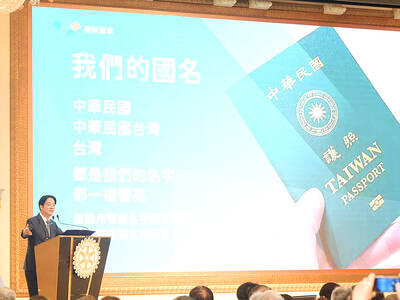Over half of cellular telephone batteries being sold on the local market have been tested as being of a lower power rating than advertised, members of the non-governmental Consumers' Foundation said yesterday.
They also said that many batteries made for use with well-known brand-names and models produced only 80 percent of the power designed for those mobile phones.
The foundation said as most of the batteries on the market were not made by the mobile phone manufacturers, the quality of the products was inconsistent at best and dangerous at worst.
This has been proven by the number of battery-burn accidents that users of mobile phones have suffered, said the foundation's director, Lee Feng-ao (
Lee said the test was conducted by an inspection committee run by the foundation, along with technical assistance from the power resources department at the National Industry Technology Research Institute (工業技術研究院).
Of the 105 products the team looked at, the foundation discovered that over 50 percent of the batteries held a charge less than the indicated amperage.
More than 60 percent of the products had a power intensity lower than the required standard for the mobile phone for which they were intended, which means, Lee said, actual battery function time is not as long as advertised.
Test results revealed that lithium batteries were of an inferior quality, with 74 percent of these batteries held a lower charge than advertised.
Seventy-eight percent of lithium batteries held a lower charge than other batteries for similar phones.
Lithium batteries are designed to have a higher power and last longer than rival nickel-cadmium batteries, which have made them popular among many consumers.
But the test results also indicated that the lithium products had a higher defect ratio, said the foundation.
Nickel-cadmium battery prices vary between NT$299 and NT$1,490, while lithium batteries cost between NT$550 to NT$2,599, or twice the price of their better-functioning rivals.

LONG FLIGHT: The jets would be flown by US pilots, with Taiwanese copilots in the two-seat F-16D variant to help familiarize them with the aircraft, the source said The US is expected to fly 10 Lockheed Martin F-16C/D Block 70/72 jets to Taiwan over the coming months to fulfill a long-awaited order of 66 aircraft, a defense official said yesterday. Word that the first batch of the jets would be delivered soon was welcome news to Taiwan, which has become concerned about delays in the delivery of US arms amid rising military tensions with China. Speaking on condition of anonymity, the official said the initial tranche of the nation’s F-16s are rolling off assembly lines in the US and would be flown under their own power to Taiwan by way

OBJECTS AT SEA: Satellites with synthetic-aperture radar could aid in the detection of small Chinese boats attempting to illegally enter Taiwan, the space agency head said Taiwan aims to send the nation’s first low Earth orbit (LEO) satellite into space in 2027, while the first Formosat-8 and Formosat-9 spacecraft are to be launched in October and 2028 respectively, the National Science and Technology Council said yesterday. The council laid out its space development plan in a report reviewed by members of the legislature’s Education and Culture Committee. Six LEO satellites would be produced in the initial phase, with the first one, the B5G-1A, scheduled to be launched in 2027, the council said in the report. Regarding the second satellite, the B5G-1B, the government plans to work with private contractors

‘OF COURSE A COUNTRY’: The president outlined that Taiwan has all the necessary features of a nation, including citizens, land, government and sovereignty President William Lai (賴清德) discussed the meaning of “nation” during a speech in New Taipei City last night, emphasizing that Taiwan is a country as he condemned China’s misinterpretation of UN Resolution 2758. The speech was the first in a series of 10 that Lai is scheduled to give across Taiwan. It is the responsibility of Taiwanese citizens to stand united to defend their national sovereignty, democracy, liberty, way of life and the future of the next generation, Lai said. This is the most important legacy the people of this era could pass on to future generations, he said. Lai went on to discuss

MISSION: The Indo-Pacific region is ‘the priority theater,’ where the task of deterrence extends across the entire region, including Taiwan, the US Pacific Fleet commander said The US Navy’s “mission of deterrence” in the Indo-Pacific theater applies to Taiwan, Pacific Fleet Commander Admiral Stephen Koehler told the South China Sea Conference on Tuesday. The conference, organized by the Center for Strategic and International Studies (CSIS), is an international platform for senior officials and experts from countries with security interests in the region. “The Pacific Fleet’s mission is to deter aggression across the Western Pacific, together with our allies and partners, and to prevail in combat if necessary, Koehler said in the event’s keynote speech. “That mission of deterrence applies regionwide — including the South China Sea and Taiwan,” he